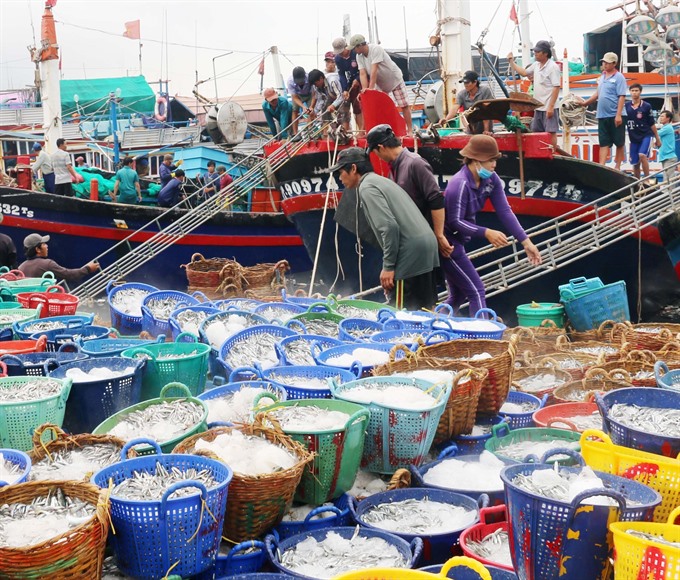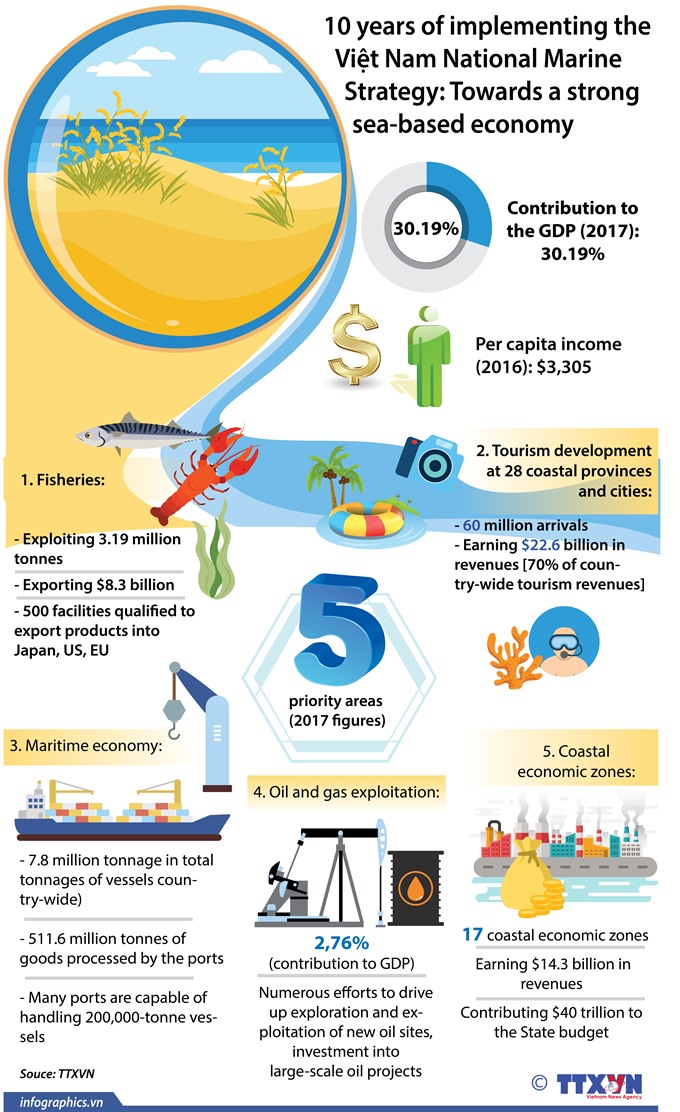 Society
Society

Việt Nam is reaping the benefits of a national strategy laid out 10 years ago to garner riches from the country’s long coastline, over 3,000 islands and abundant water areas three times the size of its land mass.
 |
| Fish is carried from boats at Cà Ná Fishing Port in Thuận Nam District, south central province of Ninh Thuận. — VNA/VNS Photo Công Thử |
HÀ NỘI — Việt Nam is reaping the benefits of a national strategy laid out 10 years ago to garner riches from the country’s long coastline, over 3,000 islands and abundant water areas three times the size of its land mass.
In 2007, the 10th Party Central Committee ratified the Việt Nam Maritime Strategy towards 2020. The strategy, and the myriad guidelines, policies and generous investment that have followed it have turbo-charged Việt
However, a wide range of challenges stands in the way of the country reaching its primary targets: ensuring the sea-based economy accounts for 53-55 per cent of the country’s gross domestic product (GDP) and per capita income in coastal areas doubles the average of the whole country by 2020.
Often seen as a key factor in the growth of a developing country, tourism is a multi-dimensional and multi-sectoral activity that greatly influences other economic sectors, including logistics, transport, trade, services, communication and banking.
In Việt
The marine economy saw strong growth in the last decade, with outputs across the fields of marine transport, port services and shipbuilding expanding by 22 per cent each year during the 2007-10 period and by 13 per cent during 2011-15.
By the end of 2017, the total tonnage of Việt
Ten years since the establishment of the marine strategy, logistics infrastructure and services have been enjoying stable growth to process the steady annual increase of 10-20 per cent in cargo load, with many ports now capable of handling 200,000-tonne ships.
With the 500 processing centres qualified to export products to demanding markets like Japan, the EU and the US, the fisheries sector is one of the fastest-growing amongst all sea-based economic activities, with total output increasing by 50 per cent over 10 years, from 2.07 million tonnes in 2007 to 3.19 million tonnes in 2017.
In the past 10 years, the Vietnamese Government has introduced several policies to promote the sector, including generous credit lines for fishermen to build ships capable of days-long offshore expenditures, making sure that all fishing vessels are equipped with information-communication devices to monitor their activities in an attempt to ward off illegal and unregulated fishing and building support infrastructure—including ports and shelters as well as financial support to compensate for post-harvest losses.
By the end of 2017, 17 coastal economic zones were established on a total area of 845,000ha and with the investment capital reaching up to $78.6 billion, in addition to 58 centralised coastal industrial zones covering 13,600ha.
The coastal economic zones generated $14.3 billion in revenue in 2017, up considerably from the $8 billion they made in 2016, and bringing in VNĐ40 trillion ($1.3 billion) in tax.
Along with the development of industrial zones in the coastal areas, new urban settlements have also been formed to provide housing and social services to cater to the large number of workers. Modern resorts and residential areas have also been built to accommodate the professionals and managers of these economic clusters – all of which help drive the urbanisation of the coastal area while creating at least 130,000 jobs.
 |
Unsustainable growth
Despite these promising statistics, there are worrying signs. The Việt Nam Administration of Seas and Islands in collaboration with the General Statistics Office are still calculating GDP, GRDP and per capita income of the coastal areas, but initial results have shown a worrying downward trend that says these locales have not lived up to expectations and are actually struggling hard to catch up with other regions in the country.
For example, sea-based economic activities contributed 48 per cent to the national GDP in 2005, right before the marine strategy was introduced, but the sector’s shares progressively scaled down to 40.73 per cent in 2010 and then 30.19 per cent in 2017.
The per capita income of people in 28 coastal localities expanded nearly five-fold in the 2006-16 period, but the values of $627 in 2006 and $3,035 in 2016 are still slightly below the national averages of $637 and $3049, respectively. The number of poor island and coastal communes more than doubled, from 157 in 2004 to 320 in 2014, failing to meet the targets of the marine strategy.
The fisheries sector, despite significant growth, is also seeing its contributions to the national GDP slide in recent years, hovering below the 2 per cent mark.
Similarly, the oil and gas sector, even with major co-operation programmes with overseas investors and beefed up attempts to explore new oil sites, accounts only for 2.76 per cent of the country’s GDP in 2017, a significant decrease from the 10.83 per cent figure in the 2007-10 period.
Professor Nguyễn Chu Hồi of the Global Ocean Forum, former deputy head of the Việt Nam Administration of Seas and
The coastal areas’ low starting point compared to other areas in the country prior to the introduction of the marine strategy in 2006, combined with misguided investment from the State (most of the funds went into infrastructure, at the expense of social welfare) and limited capacity of foreign investors are the primary causes of the limitations, Prof Hồi said.
Bùi Tất Thắng, director of the Strategy and Investment Institute under the Ministry of Investment and Planning, told the Voice of Việt Nam (VOV) that with just two years until the 2020 mark, there would need to be a sensible change in the approach to economic goals – namely, adapting the market mindset and diversifying the investment resources.
Human resources
Trần Hồng Hà, Minister of Natural Resources and Environment, said that in order to achieve the targets by 2020, the Government would need to focus on institutional reforms, advancing the adoption of science and technology, and especially the development of high-quality human resources, moving away from undue reliance on natural resources.
Vietnamese human resources, the backbone of the envisioned sea economy, were widely regarded by the national ocean administration as “inadequate, both in terms of quality and quantity” – at least in the pre-2006 period.
The management-level officials lack professional skills, the crews are equipped only to meet domestic demands and the researchers and scientists specialising in marine subjects are insufficient in number.
This was because of scant investment into human resource development, while international co-operation in sea training was not promoted.
To address these issues, in the past 10 years, the Government has issued several policies that require different ministries and local authorities to give due attention to this critical aspect.
The education and training ministry, for example, introduced incentives and support for college students or researchers coming from economically challenged coastal and island areas. It has also expanded the list of majors related to the sea and islands to a total of 20 at the undergraduate and graduate levels.
The Ministry of Labour, Invalids and Social Affairs (MOLISA) has added 15 occupations in the marine economics sector to the list of key occupations in which to support training. Pilot models were also developed to provide training and knowledge for captains and chief engineers. By 2016, more than 20,000 offshore fishermen in 16 out of 28 coastal provinces and cities had received the training, accounting for 30 per cent of eligible fishermen.
The network of vocational training institutions in coastal localities has expanded, with 90 vocational colleges, 133 vocational high schools and 454 centres currently operational.
Besides major universities like Đà Nẵng, Huế, Nha Trang and the
Some medical schools started to develop programmes dedicated to train marine medicine professionals and doctors.
Việt
Strong commitment and appropriate investment have guided the growth in the right direction, helping to bolster Việt









